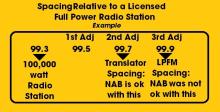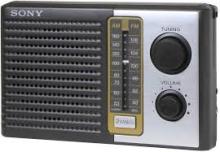Low Power FM (or “LPFM”) is a 100-watt non-commercial FM radio broadcast service developed for non-profits, churches, educational institutions, and public safety entities to take back the airwaves with meaningful locally-created programming. If you have never heard of it, it is because the roll-out has been stunted.by poor rules guiding where the stations can be located, lobbying from the commercial radio industry, and resistance from the Federal Communications Commission during conservative administrations. LPFM is currently in need of public support and legal action due to new circumstances that have curtailed its availability.
Read through below to learn more and hear about how you can help preserve the airwaves for the people.

Low Power FM History
In 2000 William Kennard, FCC Chairman under Clinton, launched LPFM service as an effort to counter the extensive ownership consolidation and erosion of diversity and localism caused by the Telecommunications Act of 1996.
Kennard stated:
LPFM stations “will benefit our communities and enhance the diversity of our society.”
Several nonprofits applied for LPFM stations during the first filing opportunity; but the radio industry was not going to have it.
Circumventing the FCC, the National Association of Broadcasters (NAB) and NPR went to Congress and passed the Radio Broadcast Protection Act (RBPA) of 2001. NAB, citing the (non-scientific, non-factual) potential for interference of these dinky stations to their larger stations, eviscerated the opportunity for applicants to apply for any urban radio channels.
Two years later, the FCC opened an opportunity for the established big broadcasters to apply for what are called “FM Translators.” Translators primarily rebroadcast programming from the big broadcasters, religious broadcast networks, and in certain cases, NPR. FM translators channel placement is much more liberal than low-power radio in where they can fit on the FM band -- with even higher broadcast power than LPFM. NAB supported translators -- which used higher wattages wedged in narrow slots between commercial stations -- but stated LPFM was an interference threat at a lower wattage in wider slots on the band.

Translators and LPFM stations today utilize the unused spaces referred to as “secondary service channels.” Due to FCC engineering rules, translators can be placed in many more spaces on the FM band than low-power stations. The FCC maintains this licensing imbalance on purpose to limit the number of low-power stations.
In 2003, the FCC opened a filing window for unlimited applications for FM translators. Hundreds of entities applied -- some filing dozens of applications -- to take all the secondary service channels in urban areas, leaving virtually no open channels for future urban LPFM.
In 2010, after years of effort by LPFM advocates, Congress passed the Local Community Radio Act (or “LCRA” for short), finally repealing the limitations. During this time, the FCC also tabled the prospect of upgrading LPFM’s broadcast power to a maximum of 250 watts from 100 watts.
After the passage of the LCRA, the FCC set out to establish a policy for balancing spectrum between FM translators and LPFM. Section 5 of LCRA mandated spare LPFM channels be “ensured” for future use, and that the local community should determine if it needed LPFM or translators:
Section 5. Ensuring availability of spectrum for low-power FM stations
The Federal Communications Commission, when licensing new FM translator stations, FM booster stations, and low-power FM stations, shall ensure that—
(1)licenses are available to FM translator stations, FM booster stations, and low-power FM stations;
(2)such decisions are made based on the needs of the local community; and
(3)FM translator stations, FM booster stations, and low-power FM stations remain equal in status and secondary to existing and modified full-service FM stations.
In 2011, the FCC opened a public-comment rulemaking process to specify the LPFM-translator application rules. Under FCC Chairman Julius Genachowski, the FCC provided a truly balanced approach to ensuring space for LPFM.
It decreed:
[O]ne of our broad principles for implementation of the LCRA is our primary focus under Section 5(1)must be to ensure translator licensing procedures do not foreclose or unduly limit future LPFM licensing. (¶59. LPFM Sixth Report & Order).
The FCC also stated:
Section 5(1) clearly requires the Commission to ensure that some minimum number of FM translator and LPFM ‘licenses are available’ throughout the nation…(¶14 LPFM Fourth Report and Order)
The LCRA necessarily requires the Commission to make choices between licensing new LPFM and translator stations in some cases, given that the two services compete for the same limited spectrum. Making such choices based on the overall spectrum available to each service does not ‘favor’one service over the other. (¶17 LPFM Fourth Report and Order)
[W]e find that LPFM stations are uniquely positioned to meet local needs, particularly in areas of higher population density where LPFM service is practical and sustainable (¶18 LPFM Fourth Report & Order)
The Section 5(2) directive to base translator and LPFM licensing decisions on the ‘needs of the local community’ could be interpreted to concern solely the needs of communities for additional LPFM service on the theory that translators cannot be expected to provide meaningful localservice, at least in larger markets.(¶14 LPFM Third Further Notice)
Within the FCC analysis it determined that LPFM stations were better suited and had greater demand in central city areas, and translators were better suited for rural areas. Furthermore, it determined that in spectrum-limited markets (where there was a scarcity of open FM channels), that at least a certain amount of channels should be made available for future LPFM’s. This policy led to the dismissal of pending FM translator applications from 2003 that blocked LPFM’s.. The FCC used a “grid” system to map open channels within each radio market to make sure LPFM channels were spatially balanced.
In 2013, the FCC opened a couple-week period (a “filing window”) for nonprofits to apply for new LPFM stations. New LPFM stations can only be applied for within these windows (there have only been two in the last 20 years). Based upon local knowledge of the opportunity, the number of applicants per city varied greatly.

In some cities, there were only a few channels open for new stations due to the stringent placement requirements. LPFM follows a “distance-spacing” regimen. That means a channel selected must protect other stations up to three channels over up and down via a station-to-station spacing chart (see chart https://www.law.cornell.edu/cfr/text/47/73.807).
So in many cases, while nothing may be heard on a particular channel except static, it still might not be open to LPFM. For this reason, for example, only two or three channels were available in San Francisco, even though many translator channels may have been fit to broadcast upon. Each one of the translator channels has coverage several times bigger than the LPFM channel, with much higher heights, and a maximum wattage of 250 watts. It is extremely unfair.
Current Issue
After the 2013 filing window, the FCC went on to draft new rules affording each AM radio station an opportunity to apply for “fill-in FM translators” within their AM Revitalization Rulemaking (or “AMR”). Instead of opening a new digital radio band for AM licensees, the FCC’s answer to diminished AM listenership was to attempt to cram the whole AM band on the FM band.

These fill-in translators, called cross-service FM translators when rebroadcasting AM,, can operate up to 250 watts at unlimited height as long as the primary coverage contour of the FM translator does not exceed the primary cover contour of the AM station. At times, this can be up to 40 times the coverage area of a LPFM station.
Since the LCRA was enacted, the FCC had paid attention to making sure spectrum for LPFM was retained in spectrum-limited market. That regimen was discarded after AMR. The FCC went on to open four periods for AM station owners to license or relocate translators on any open frequency.
What ensued was that virtually all LPFM opportunities were eviscerated in urban areas. In a broad effort, Common Frequency, Prometheus Radio Project, and Center for International Media Action drew attention to this by filing a consolidated objection to close to one thousand pending translator applications.
Our contention was that neither the FCC nor the applicants made any effort to protect future LPFM channels pursuant to LCRA. The FCC denied the objection, swiftly granting all the translators in record time. CF and PRP appealed with a Petition for Reconsideration. It was denied on procedural issues, but stated PRP retained standing, and deferred judgement on the Reconsideration for over a year.
In February 2020, the FCC released a decision again denying the contest. The FCC stated it adhered to LCRA because the filing opportunity had stipulations to limit the number of applications accepted. The limitations did not have anything to do with ensuring channels. The FCC ignored all the filing data presented by CF and PRP.
PRP and CF pursued further FCC Review of the Reconsideration denial on March 4, 2020. We comprehensively demonstrated that the FCC is in violation of the Administrative Procedure Act (APA) and failed to look at the records that demonstrate no open LPFM channels were retained. At the heart of the issue, the FCC abandoned its own policies guiding the conservation of LPFM channels. The APA requires that government agencies adhere to their own rules.
Our expectation is that the FCC will deny the Application for Review again.
At that point, our only option will be to appeal the issue in court.

Since 2017, the FCC has granted the commercial broadcast industry its deregulatory wishlist. It has bent over backwards to fast track FM translator spectrum to AM broadcasters, and even expedited a translator interference proceeding to make it harder to challenge translator interference. This was placed into effect despite Petitions for Reconsideration pointing out anomalies in the new rule
The FCC continues to suppress the development of LPFM now that it is a mature service. Per FCC report of March 31, 2020, there are 8188 licenced FM translators and booster and 2159 LPFM stations. Recently, the FCC released a Report & Order from a LPFM rulemaking that was supposed to improve the LPFM technical rules. Instead, ignoring much public comment, the FCC failed to upgrade LPFM from 100 to 250 watts without any legitimate reason. It also stipulated new rules for pattern-testing directional LPFM antennas -- an added fee of thousands of dollars -- when FM translators do not require any pattern testing. The new rulemaking also maintains that LPFM stations have to buy certified transmitters which full power and translator stations are not required to use. It is discouraging that the FCC is handicapping LPFM on behalf of the broadcast industry.

Our next step is to challenge this decision in appellate court. But it takes dollars to issue this challenge on behalf of community broadcasters.
We need to raise $25,000 dollars to take the FCC to court and protect LPFM.
If we reach our initial goal of $15,000, we’re going to court!
We're not ready to start collecting donations yet, but we wanted to put out this explanation of what is going on to the radio community so we can start brainstorming how to fund this effort.
Yours in broadcasting,
Common Frequency
